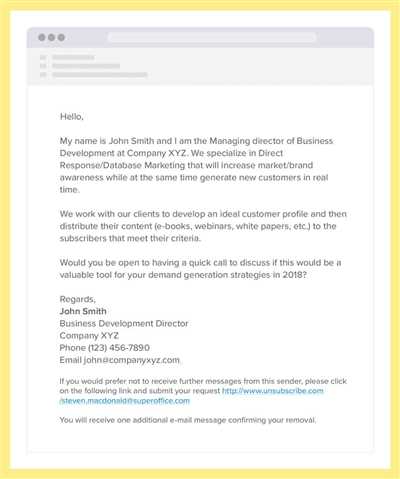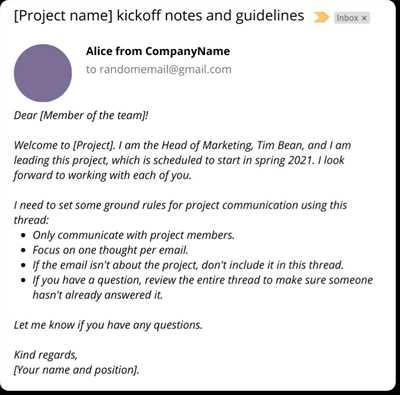
When it comes to email etiquette, knowing how to start an email to a company is crucial. The opening of your email sets the tone and can make a lasting impression. Whether you’re emailing someone you know or contacting a company for the first time, there are certain ways to ensure you begin your message in a professional and respectful manner.
One important consideration is the salutation. If you know the name of the person you’re emailing, starting with “Dear [Name],” is always a good choice. This shows that you’ve taken the time to find out who you’re communicating with and adds a personal touch to your email. However, if you’re unsure of the person’s gender or prefer a more neutral greeting, using “Hello” or “Hi” followed by their name is also acceptable.
Another option is to use a more formal salutation like “Good morning,” “Good afternoon,” or “Good evening.” These greetings are appropriate for professional or business-related emails and show respect to the recipient. If you’re addressing a boss or someone in a higher position, it’s better to use a more formal salutation.
On the other hand, if you don’t know the name of the person you’re emailing or you’re contacting a general email address like [email protected], you can use a more generic salutation like “To whom it may concern” or “Dear Sir/Madam.” These salutations are useful in situations where you’re unsure of the best person to address your email to.
Furthermore, if you’re emailing a group or a team, you can use a collective salutation like “Hello everyone” or “Hi team.” This way, you’ll avoid singling out one person and show that you’re addressing the entire group.
It’s also important to consider the tone of your email. If you’re writing a more formal or official message, using a professional title like “Professor” or “Dr.” followed by the person’s last name is a respectful way to address them. However, if you have a casual or familiar relationship with the person, using their first name is appropriate.
In any situation, you want to make sure your email starts on the right foot. Using a respectful and appropriate salutation, followed by a clear and concise opening, can help you create a positive impression. Remember to be concise, polite, and to the point when crafting your opening, as it sets the stage for the rest of your message.
Overall, there are many ways to start an email to a company, and the most important thing is to consider the context and the person you’re contacting. By demonstrating respect, being clear in your message, and using appropriate salutations, you’ll increase the chances of receiving a prompt and helpful response to your email.
- 40+ Ways to Start an Email That Are So Much Better Than “Happy Monday”
- Professional Email Greetings
- 1 Dear name
- 2 Good morning afternoon evening
- 3 Hello name
- 4 Hi team
- 5 Greetings
- How to Write a Formal Email
- How to Punctuate Email Greetings The right email openings for every situation
- Frequently asked questions
- Video:
- Unlimited Business Emails for FREE? | Ali Solanki
40+ Ways to Start an Email That Are So Much Better Than “Happy Monday”

When it comes to writing emails, the salutation is an important part of the message. It sets the tone and shows respect to the person or group you are addressing. If you’re unsure about what to write in the opening line of your email, here are 40+ greetings that are more professional and respectful than the generic “Happy Monday”.
1. Hello
2. Hi [Person’s Name]
3. Dear [Person’s Name]
4. Good [Morning/Afternoon/Evening]
5. [Person’s Name],
6. To the [Department/Team/Group],
7. It’s a pleasure to be emailing you,
8. I hope this email finds you well,
9. I’m reaching out to you because,
10. Thank you for your time
11. I wanted to ask you about,
12. I have some questions regarding,
13. I hope everything is going well with you,
14. I hope you’re having a great day,
15. I hope this email doesn’t interrupt you,
16. I’m writing to address the issue of,
17. I hope you had a good weekend,
18. Would it be possible to,
19. I trust this email finds you in good health,
20. I apologize for the inconvenience,
21. I wanted to follow up on our previous discussion about,
22. I’m writing to provide you with an update on,
23. I’m writing to seek your advice on,
24. I hope you don’t mind me reaching out to you,
25. I wanted to let you know that,
26. I hope I’m not disturbing you,
27. I appreciate your prompt response,
28. I wanted to share some exciting news with you,
29. I’m writing to express my gratitude for,
30. I wanted to share my thoughts on,
31. I hope you’re enjoying your day so far,
32. I hope you’re doing well,
33. I hope all is well,
34. I hope this email finds you in good spirits,
35. I hope this email finds you in good condition,
36. I hope this email finds you in high spirits,
37. I hope this email finds you in good shape,
38. I hope this email finds you in good form,
39. I hope this email finds you in good health and happiness,
40. I sincerely hope this email finds you well.
These openings can be followed by the person’s name, a citation, a reference to something important, or a question to engage the recipient. Remember to address the email to the right person or department and include their email address. Whether you’re emailing someone you know well or in a formal situation, it is important to start the email on a good note!
Professional Email Greetings
When writing a professional email, the greeting is the first impression you make on the recipient. It sets the tone for the rest of the message and can greatly impact how your email is received. Here are some tips on how to start your email with a professional and appropriate greeting:
1. Use a personal touch: Address the person by their name, rather than using a generic greeting like “Dear Sir/Madam”. This shows that you have taken the time to research and know who you are contacting.
2. Be neutral and respectful: If you are unsure about the gender of the person, it’s better to use a neutral greeting like “Dear [First Name] [Last Name]” or “Hello [First Name]”. This avoids any potential mistakes or misgendering.
3. Consider the recipient’s title: If you are writing to someone with a known title like “Professor”, “Doctor”, or “Mr./Ms./Mrs.”, make sure to include it in the greeting. This shows respect and acknowledges their professional status.
4. Use appropriate greetings based on the situation: The type of greeting you use will depend on the context and the relationship you have with the person. For formal emails, use a greeting like “Good morning” or “Good evening” followed by the person’s name. For more informal emails, you can use a simple “Hello” or “Hi [First Name]”.
5. Avoid casual or overly personal greetings: While it’s important to be friendly, keep in mind that a professional email should maintain a level of formality. Avoid using greetings like “Hey” or “What’s up?” as they can come across as too casual and unprofessional.
6. Don’t miss the subject line: While not technically a greeting, the subject line is just as important in emails. Make sure to include a clear and concise subject line that summarizes the content of your email. This helps the recipient know what to expect and increases the chances of your email being opened and read.
In conclusion, the way you start your email with a professional greeting is important. It shows respect, attention to detail, and sets the tone for the rest of your message. By following these guidelines, you can make a positive impression and enhance your professional communication skills.
1 Dear name
When starting an email to a company, it’s important to use an appropriate salutation to address the person or team you are contacting. The salutation sets the tone for the rest of the email and shows respect to the recipient.
If you know the name of the person you are addressing, it’s better to use a formal greeting, such as “Dear [Name],” followed by a comma. This shows that you have taken the time to find out who you are emailing and adds a personal touch to your message.
However, if you are unsure of the recipient’s name or you are contacting a larger group or department, it’s acceptable to use a more neutral greeting such as “Hello,” or “Hi,” followed by a comma. This is a more casual and informal way to start an email, but still respectful.
If you haven’t been given a specific name or contact person, you can use a more general salutation like “To whom it may concern,” followed by a colon. This should be used when you are addressing a department or a general email address.
In some situations, it might be appropriate to use a more specific salutation such as “Dear Hiring Manager,” or “Dear Professor [Last Name],” depending on the nature of your email. This shows that you have done your research and are specifically addressing someone in a certain role or position.
Regardless of the salutation you choose, it’s always a good idea to keep it professional and respectful. Starting your email with the right salutation sets the tone for the rest of your message and shows that you are taking the communication seriously.
2 Good morning afternoon evening
When writing an email to a company or a professional contact, it is important to start with a greeting that is respectful and sets a positive tone. The way you open your email can have a big impact on how your message is received, so it’s worth taking the time to think about the most appropriate way to start.
Here are some ways you can start your email:
- Good morning/afternoon/evening – Using a greeting based on the time of day is a very common and acceptable way to start an email. It shows that you are aware of the time and respectful of the recipient’s schedule.
- Hello – This is a neutral and friendly greeting that works well for both formal and informal emails. It is a safe choice when you are not sure what level of formality to use.
- Hi [Name] – If you know the person’s name, using it in the greeting can make the email feel more personal and friendly. This is a good option if you have a casual or professional relationship with the recipient.
- Dear [Name] – This is a more formal and traditional greeting, often used in professional or academic settings. It is a respectful way to address someone you don’t know very well or when you want to show a higher level of respect.
It is also important to remember to include a closing line in your email. A simple “Sincerely” or “Best regards” followed by your name is usually appropriate for most business or professional emails.
When starting your email, think about the person or group you are writing to, and try to tailor your greeting to their preferences and the context of the situation. If you are writing to someone you don’t know well or in a more formal setting, a more traditional greeting like “Dear Professor Smith” might be better. On the other hand, if you are writing to a group of colleagues or a close contact, a more casual greeting like “Hi team” could be more appropriate.
Take a look at the following citation from Professor Jane Smith: “It’s better to err on the side of being too formal at the start of an email rather than too casual. Starting with a respectful greeting like ‘Dear’ or ‘Good morning’ shows that you are taking the communication seriously.”
In summary, the way you start your email sets the tone for the entire message. Use a greeting that is respectful, friendly, and appropriate for the situation. Pay attention to the preferences of the person or group you are writing to, and always aim to start on the right foot.
3 Hello name
Greetings are important when starting an email, as they set the tone and make your message more personal and respectful. When addressing someone you know well or in a casual situation, you can use a more informal greeting. However, when writing a formal email to a company or someone you don’t know well, it is best to use a more professional and respectful greeting.
If you don’t know the name of the person you are emailing, you can start with a generic greeting such as “Hello” or “Dear Sir/Madam.” It’s always better to address a person by their name if you can find it. If you are unsure whether the person you are emailing is a man or a woman, you can use a neutral greeting such as “Hello” or “Dear [First Name] [Last Name].” This shows respect and avoids any use of incorrect titles or assumptions.
When using a person’s name in your greeting, it’s best to use their full name or the name they prefer to be called. For example, if the person’s name is John Smith, you can say “Hello John” or “Dear Mr. Smith.” If the person has a professional title, such as Professor or Dr., you can include that in the greeting as well: “Hello Professor Smith.”
It’s also important to consider the time of day when starting your email. If you are writing in the morning, you can use a greeting such as “Good morning” or “Hello.” If you are writing in the afternoon, you can use “Good afternoon.” In the evening, you can use “Good evening.” Using these greetings shows that you are aware of the time and are being considerate.
Depending on the situation or your relationship with the person you are emailing, you might want to add something personal or related to your email. For example, you can say “I hope you’re doing well” or “I hope you had a great weekend.” These small details can show that you care and are interested in the person’s well-being.
In conclusion, when starting an email, it is important to use a respectful and professional greeting. Address the person by their name if possible, or use a neutral greeting if you are unsure about their gender. Consider the time of day and include a personal touch if appropriate. Starting an email on the right note can set a positive tone for the rest of the message.
4 Hi team
When it comes to starting an email, you might be unsure what salutation to use. In more formal emails, it’s common to start with “Dear” followed by the person’s name or title. However, in a casual or personal email, you can use a more open and friendly greeting like “Hi” or “Hello”.
If you’re emailing someone from a company or department where you haven’t been frequently in contact or you don’t know the person well, a more neutral and respectful opening like “Hello” or “Hi team” might be a better choice.
It’s also important to consider the time of day when writing your email. If it’s in the morning, you can start with “Good morning” or “Hello”. In the afternoon, you can use “Good afternoon”. If it’s in the evening, “Good evening” is appropriate.
When you’re unsure of the person’s gender or you want to include everyone in the team, you can use a gender-neutral salutation like “Hi team” or “Hello everyone”. This way, you don’t miss out on addressing someone correctly or making them feel excluded.
If you’re writing to a professor or someone in a position of authority, “Dear Professor [Last Name]” or “Dear [Title] [Last Name]” is a more respectful way to start your email.
Here are some acceptable openings for your emails:
- “Hi team”
- “Hello everyone”
- “Good morning, [Name]”
- “Good afternoon”
- “Dear [Title] [Last Name]”
Remember to always start your email with a greeting to show politeness and respect, and don’t forget to include your own name or a closing message like “Sincerely” or “Best regards” at the end.
5 Greetings
When starting an email to a company or organization, it’s important to begin with a professional and respectful greeting. Here are 5 greetings that you can use:
| Greeting | Explanation |
| Hello | This is a neutral and commonly used greeting. It can be used in both formal and informal situations. |
| Good morning/afternoon/evening | These greetings are time-specific and can be used depending on the time of day when you are writing the email. They are more formal and show respect. |
| Dear [Title] [Last Name] | This is a formal greeting that is commonly used when you know the person’s name and title, such as “Dear Professor Smith” or “Dear Mr. Johnson”. |
| To whom it may concern | This is an acceptable greeting to use when you are unsure who will be reading your email. It is more formal and should be followed by a colon. |
| Hi [First Name] | This is a more casual and informal greeting that can be used when you have a more personal or informal relationship with the recipient. It’s important to use this greeting only if you are on a first-name basis with the person you are emailing. |
Remember, the greeting you choose should be appropriate for the situation and the level of formality you want to convey. It’s always better to be too formal than too casual when contacting a company or someone you don’t know well.
How to Write a Formal Email
When writing a formal email, it is important to start with a proper salutation. Begin the email by using a neutral and professional greeting such as “Dear” followed by the person’s name and a comma.
For example: Dear Mr. Smith,
If you don’t know the person’s name, you can use a generic greeting like “Dear Sir/Madam,” or “To whom it may concern,”.
The opening of your email should be concise and to the point. Start by introducing yourself and stating the purpose of your email. For example, “My name is John and I am writing to inquire about…” or “I wanted to write to you regarding…”.
Be sure to use proper punctuation and capitalization in your email. Avoid using excessive exclamation marks or all capital letters, as this can come across as unprofessional and even aggressive.
When addressing someone, use a polite and respectful tone throughout the email. Remember to use appropriate language and avoid using slang or informal expressions.
If you are emailing someone in a professional capacity, it is best to keep the email focused and business-like. Save personal or unrelated questions for a separate email or conversation.
It is also important to be clear and concise in your email. Make your points quickly and avoid writing long, rambling paragraphs. Use bullet points or numbered lists to break up information and make it easier to read.
In a formal email, make sure to include a subject line that clearly relates to the content of your email. This will help the recipient understand the purpose of the email before opening it.
Always double-check the spelling of the recipient’s name and email address before sending the email. Addressing the person incorrectly can come across as careless or unprofessional.
At the end of your email, use a closing such as “Sincerely,” followed by your full name. If it is a more formal email, you can use “Best regards,” or “Thank you,” followed by your full name.
Remember to proofread your email before sending it to ensure there are no errors and that your message is clear and professional.
By following these guidelines, you can write a formal email that is respectful, clear, and professional.
How to Punctuate Email Greetings The right email openings for every situation
Starting an email can sometimes be tricky. You want to make sure your greeting is appropriate for the situation and the person you are addressing. Here are some ways to start your email greetings:
- Formal: If you are emailing someone you don’t know or an important person, it’s best to use a formal greeting. Begin with “Dear” followed by the person’s title and last name, such as “Dear Professor Smith” or “Dear Dr. Johnson.”
- Informal: In a more casual situation, like emailing a colleague or someone you know well, you can use a more relaxed greeting. Simply address the person by their first name, like “Hi Jane” or “Hello John.”
- Neutral: If you’re not sure how formal or informal to be, a neutral greeting can work well. Address the person by their professional title, such as “Good morning, Mr. Johnson” or “Good afternoon, Ms. Smith.”
- Related Group: When emailing a group of people who are all related to the same department or organization, you can start with a general salutation like “Dear Marketing Team” or “Hello Finance Department.”
- Time of Day: If you want to acknowledge the time of day, you can use greetings like “Good morning,” “Good afternoon,” or “Good evening.” For example, “Good evening, John,” or “Good morning, Ms. Smith.”
Remember to always end your email with an appropriate closing, such as “Sincerely” or “Best regards.” And don’t forget to sign off with your full name and contact information. Happy emailing!
Frequently asked questions
Here are some frequently asked questions about how to start an email to a company:
| Question | Answer |
| 1. What salutation should I use when emailing a professional group or department? | It is always best to start with a respectful opening. Use a formal salutation like “Dear [Department Name] Team” or “Hello [Department Name]”. |
| 2. How should I address someone if I am unsure of their gender? | If you are unsure of someone’s gender, it is best to use a neutral salutation like “Dear [First Name Last Name]” or “Hello [First Name Last Name]”. Avoid using gender-specific titles like Mr. or Ms. |
| 3. What salutation should I use if I know the person’s name? | If you know the person’s name, it is best to address them directly. Use a formal salutation like “Dear [First Name Last Name]” or “Hello [First Name Last Name]”. |
| 4. Is it acceptable to use informal greetings like “Hi” or “Hello” in a professional email? | Using informal greetings can be acceptable in certain situations, like when emailing a colleague or someone you have an established relationship with. However, it is generally best to use a more formal greeting, especially when emailing someone for the first time or in a formal setting. |
| 5. Is it important to include a salutation in every email? | While it is common to include a salutation in most professional emails, there may be situations where it is not necessary. For example, if you are responding to a thread where the previous messages have already established a formal tone, you may choose to skip the salutation. Use your judgment and consider the context. |
If you still have questions that haven’t been answered here, feel free to ask!









